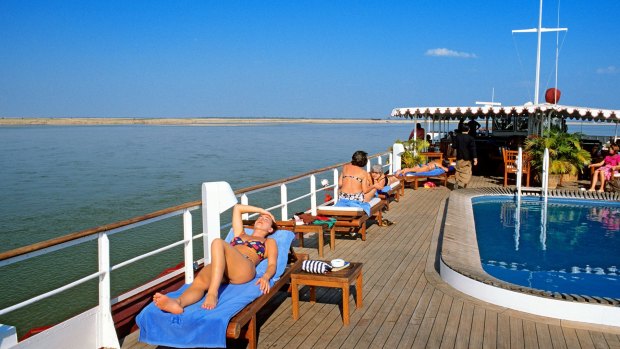This was published 6 years ago
River cruising tips: The seven biggest myths about river cruising, busted
By Brian Johnston
People who've never been on a river cruise are sometimes quick to judge – and dismiss – this style of travel. Here are seven persistent myths that might make you change your preconceptions about having a holiday afloat.
1. River cruises are expensive
Some are, some aren't. Like any holiday, you get what you pay for. A river cruise costs between $200 and $500 per person per night. At the budget end, cruises can offer extraordinary bargains, but even luxury cruises can be good value. Compare the cost of a river cruise to a land holiday, and consider it includes accommodation, meals, enrichment programs and (nearly always) guided shore excursions. You might also get inclusive butler service, drinks, gratuities and airport transfers, even flights. That can make costs hard to match compared to doing it yourself. And of course, it's all organised for you, hassle-free.

You'll certainly have nothing to do when it comes to housework, cooking and travel organisation. Though you may find yourself too busy to lie around on deck.Credit: Alamy
2. I'll be bored
You'll certainly have nothing to do when it comes to housework, cooking and travel organisation. But on a river cruise it will sometimes seem you're too busy to take time out to lounge on the deck. You can do as much as you would on a regular holiday. River ports such as Amsterdam, Frankfurt, Paris or Ho Chi Minh City are crammed with sights, shops and markets, museums and nightlife. Smaller destinations provide opportunities to visit castles, temples, cellar doors and farms. Organised shore excursions range from general sightseeing to insider tours that focus on special interests such as beer, music, history or a particular city neighbourhood.
3. River cruising is all about the Rhine and Danube
If for some strange reason you're bored by these most-cruised rivers, take heart. There are many more: several rivers in France, Portugal's Douro, the Volga waterways in Russia and more "obscure" rivers such as the Guadalquivir in Spain, Dneiper in Ukraine or Tisza in Hungary. And while it's true that Europe is river-cruising's heartland, Asia is now a big destination too, with cruises on the Yangtze, Mekong, Ganges and Irrawaddy. You can also cruise the Amazon River in Brazil and Peru, the Columbia and Mississippi rivers in the USA and our own Murray River, among many other options.
4. River cruises are all the same
If you think you've "done" river cruising just because you've sailed a couple of times, then really, you've only just got going. River cruising can be as varied as any other holiday. Take the Mekong River alone: you can bird watch in protected marshes, visit the ancient temples of Angkor Wat and the more recent and disturbing Khmer Rouge prisons, plunder markets, take cooking classes and make school visits. Also notable worldwide is the rise in themed river cruising, with itineraries covering special-interest areas such as wine, Jewish history, opera, golf, World War sites in northern France and much more.
5. River cruising isn't for the active
The old cliche about cruising being for the nearly dead and overfed is outdated. (Well, perhaps not the overfed bit.) The average age of river passengers is falling and, in response, companies are providing more active choices. Many river ships have a small gym, carry bicycles and Nordic walking sticks, and offer morning yoga classes. The ship's concierge can recommend onshore jogging routes, and shore excursions might offer cycling, hiking and kayaking. Don't underestimate the energy needed just for the regular program either. Days are long, and tours can involve several hours of walking often, in Europe, over uneven surfaces such as cobblestones.
6. River cruising isn't for families
This was certainly the case until relatively recently, with river-cruise companies focusing almost exclusively on the retiree market. But that's changing, with a few companies now offering great multi-generational cruises with shore excursions and activities targeting children or grandchildren, and interconnecting cabins designed with families in mind. Uniworld, Tauck and Adventures by Disney have family sailings in Europe, and Pandaw has a limited number in Asia. Christmas market cruises in Europe are also a good option for families. Be aware, though, that river ships are much smaller than ocean ships, with no space for kids' clubs or activities, so they aren't suitable for the hyperactive.
7. You're always on tour
You're mistaken if you think river cruising is a series of slow shuffles in a large group around crowded palaces or cathedrals. It is sometimes, of course. It might equally be a small group doing an "insider" guided walk around an interesting city district. Anyway, you aren't sent to the naughty corner for not joining an organised tour. River ships are often docked the entire day in town centres, with ample chance to wander off by yourself. Besides, shore excursions seldom run all day. You can join a half-day tour for an overview and to get oriented, then slope off for individual exploration.
See also: Nine stunning European rivers you'd never heard of
Sign up for the Traveller Deals newsletter
Get exclusive travel deals delivered straight to your inbox. Sign up now.